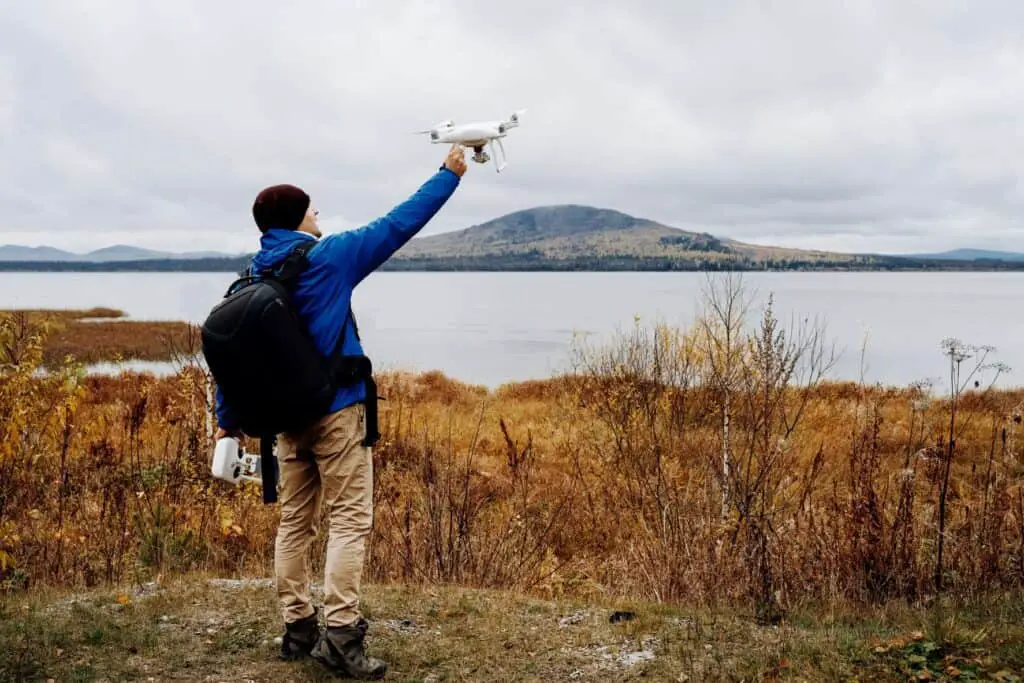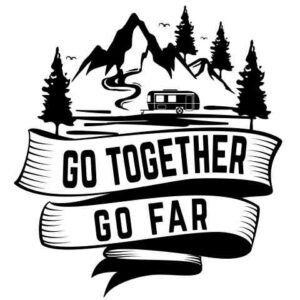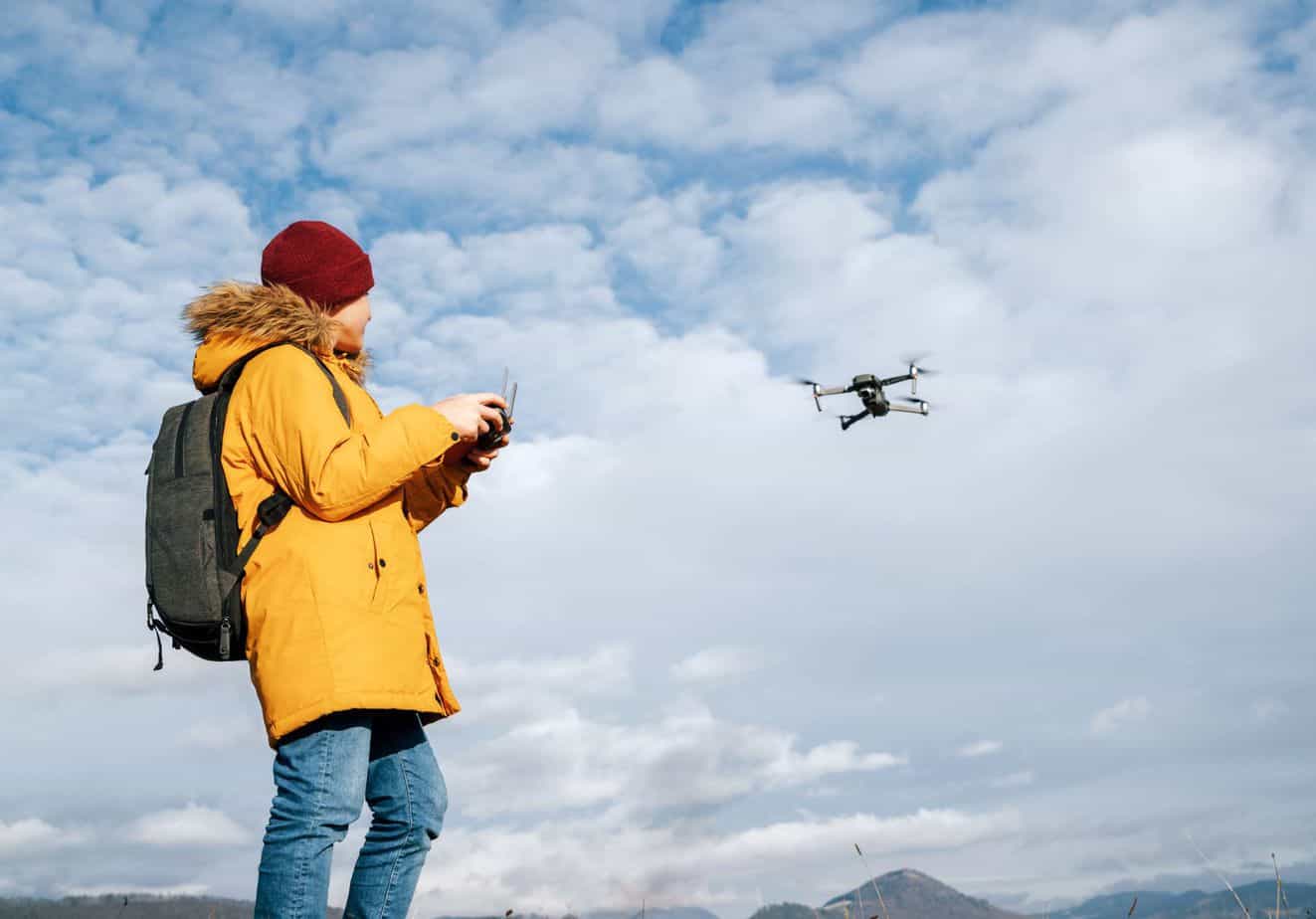Drones are great tools and toys for your outdoor adventures. Whether you need a drone for photography, videography, exploration, or racing, there are lots of different drones with varying functions to choose from.
The best drone for camping, backpacking, and RVing is a multirotor drone that minimizes weight, packs efficiently, and offers the best photo quality. A drone that’s too heavy and inconvenient to carry will become a burden when exploring the outdoors.
Fortunately, there are many options when it comes to buying a drone. The most common drones for outdoor enthusiasts are multirotor drones. You can choose one that packs efficiently or whichever design makes it the perfect tool for camping, backpacking, or RVing!
Types of Drone
Figuring what type of drone you want for your trips is essential when deciding what drone to pick. They are several things you can use a drone for, whether it be:
- Photography
- Videography
- Exploration
- Flying
Additionally, it’s important to buy a drone based on your experience and budget. If you are a first-time drone user, it’s better to buy a cheaper toy drone to learn how to maneuver it before investing in a better-quality one.
Don’t forget to check out our Recommended RV Equipment list!
Mini Drones
Like the name, these are tiny drones that can fit in your pocket. They are affordable drones with a limited range and battery life. Costing around $100 or less, these drones are small and easy to fly, meaning they can survive minor crashes, and their spare parts are available at a low price.
Generally, you can operate these drones indoors. Although you can’t fly these drones for more than 10 minutes, they are great for beginners.
It’s possible to buy a mini drone with a built-in camera, but the photo or video quality can be low. However, you could buy a mini drone with good photo quality, such as the DJI Mavic Mini with newer technology.
Regardless of their limits, these drones are budget-friendly and a great way to learn the fundamentals of flying. Consider buying and practicing with a beginner drone before upgrading to a higher-quality one.
Hobby Drone
Hobby drones are one step up from mini drones. They are midsize, usually cost under $200, and durable. Like the mini drones, their spare parts are relatively inexpensive.
Hobby drones also offer advanced features for more experienced flyers. In addition, they can come with higher quality cameras, camera attachment options, longer ranges, and flight time. Moreover, most have GPS installed.
These hobby drones can be fantastic for capturing casual photos, scouting out your environment, searching for specific landmarks, and getting your bearings on a location. Their use makes these the perfect drones for RVers, backpackers, and campers.
Professional Drone
As expected, these drones are higher-end and more expensive, ranging from $500 to $1000+. The drones come equipped with specialized cameras, automatic flight modes, GPS tracking systems, bigger batteries, and advanced features. Therefore, they are perfect for professional photographers.
Professional drones usually have four or more rotors, brushless motors, three-axis gimbals, and a steady platform for lenses. For videos, drones can come with gimbals to cushion the camera from its motors’ vibrations. Additionally, these drones have gimbals or the ability to add them on, allowing you to pan and title the camera while maintaining smooth quality.
Professional Drones need to be registered with the FAA because the extra features make them larger and heavier than toy drones. However, that also means they have a longer flight time, which lasts around 20 minutes. Some can even fly up to 50 minutes!
These drones are fantastic for high-quality aerial shots as well as looking down places you can’t reach. They’re incredible for filming your glamorous RV driving down the road.
Racing Drone
These drones are smaller and built for speed, flying up to speeds of 70MPH or faster! Additionally, they have built-in first-person cameras that you can use with a pair of VR goggles to feel like you’re flying in it.
As an RVer, you can find spacious open places for flying rather than in the city. Racing drones are a great choice if you love flying drones competitively and use outdoor spaces as practice grounds. However, for photography, these drones are unsuitable.
Summary
Depending on what you plan to use a drone for, there are various types to pick from. If you’re a beginner, opting for a mini drone is a fantastic way to practice flying and learn the basics of a drone before investing in a pricier one.
If you’re a photographer with drone flying experience, you can buy a hobby drone or a professional one. However, you can get mini drones that have fantastic cameras.
What to Look for in a Drone
Suppose you plan on buying a professional drone for hiking and getting that fantastic scenery and aerial photos. Here are a few things to look for in the drone itself. Additionally, if possible, you can use a flight simulator to know how to fly the drone better before the real thing.
Rotors
Most professional drones are multi-rotors because it’s more stable and easier to fly. Among the multi-rotors, there are:
- One rotor or helicopter
These can carry heavier loads, but they are the hardest rotor drones to fly.
- Bicopter
These are rare, but the newer V-shaped bicopter from Zero Zero Robotics has flight times of up to 50 minutes.
- Tricopter
These are also rare. Plus, three rotors tend to be more unstable when flying.
- Quadcopter
Four rotors are the most common. They’re power-efficient and excellent at handling weight.
- Hexacopter
The extra rotors mean more weight load capacity, power, and redundancy. They can handle carrying DSLRs
- Octocopter
Octocopters have even greater power and redundancy than hexacopters. They can also carry heavy weight loads.
Lastly, there are designs without rotors (i.e., wings), but their oversized frames don’t fold and are not great for photography.
Size
Size comes into play depending on the camera you use. If you need a drone for RVing, you can consider purchasing a heavier drone. However, a drone for backpacking should be lighter and easy to carry.
With current improvements in technology, you can buy mini drones with great built-in cameras. Midsize drones could also have great built-in cameras or attachment features. However, for professional photography or videography, you’d have to buy a large-sized drone.
Large-size drones are also great for windy conditions because smaller drones would get blown away. Moreover, you can find a lightweight one with foldable rotors.
Ease of Use
Professional drones come with a variety of valuable functions such as:
- Headless Mode
This mode means your drone’s head always faces the same direction as you. Therefore, your drone will do the same if you move right, making it much easier to fly.
- GPS
Like with your phone and car, it makes navigating and exploring your environment more manageable. It almost allows your drone to use certain features better, such as automatic flying or object avoidance.
- Auto-Pilot
This feature allows you to choose a location and fly there and back without your maneuvering.
- Return Home Feature
This feature allows you to simply press a button, and the drone will fly back to you like the Holy Stone HS720. Note that if your drone doesn’t have GPS, it might hit objects or fly in the wrong direction if you have headless mode off.
Camera Quality
Whether you need a drone with a camera for camping or professional shoots. You can get built-in cameras or attachments that allow you to put your preferred camera. The better quality the camera, the more expensive it’ll be.
If you’re a professional with specific requirements, you can research the camera specifications or attachments to accommodate your camera.
When filming footage, consider drones with gimbals or attachments for gimbals. Gimbals make your footage smoother. The best gimbals are ones with three-axis like this DJI Mavic pro. Ones with two-axis are cheaper, but your video could still be wobbly.
Moreover, you can get drones with brushless motors like this Ruko F11 pro, meaning they won’t affect your camera.
Durability
The frame is essential when it comes to durability. Choose one that’s at least 4 ml thick without too many holes that cut down on weight. The holes can impact the structural integrity of the frame.
Additionally, examine how well it protects specific components. Components that require protection include:
- Camera Lens
Having a frame that covers the entire lens will prevent it from shattering upon impact.
- Motors
Frames with slightly longer arms will protect the motor blades from snapping.
- ESCs and Wires
The better the frame covers the ESCs and wires, the lesser chances they’ll be nicked by the spinning rotor blades.
- Antenna from Snapping
Drones with a flex point (i.e., only the bendable part if sticking out) means the antennas are less likely to snap upon impact.
- Antennal Lobe
This part of the drone is the easiest to break open, exposing the antenna. Make sure glue or something is holding the seam together to avoid splitting apart in the event of a crash.
- Batteries
Look for battery straps or tighter battery cases that’ll prevent your battery from coming loose or being ejected during a crash and being lost.
In addition to the frame, look for suitable standoff assemblies. One with a metal standoff that holds all the layers of the electronic stack is better than one with a standoff per layer. One solid standoff makes sure all the boards are mounted together, offering a more solid mount.
Also, bumpers and landing pads will soften crashes, prevent damage to the frame, and protect the bottoms of your drones. Landing skids are an excellent alternative so that your drone can slide as it lands.
Range
When you’re outdoors, you’d want your drone to have an excellent range to film over the sea or mountains. Beginner drones only go up to 110 yards. However, advanced professional drones will have ranges up to 3 miles, perfect for any camping, backpacking, or RV trip.
Flight Time
One of the most critical features is flight time. It can be annoying if you have to stop and charge your drone constantly. More advanced drones will have flight times of up to 30 minutes, although some newer models claim to fly up to 50 minutes.
You can also purchase extra batteries to skip the charging time, but you’d still have to stop your drone from switching them out. So consider the costs of spare batteries when purchasing your drone.
Case
Buying a proper case is vital for protecting your drone. Good drone cases have built-on foam interiors that protect your drone from damage during your RV drive. Plus, you can get cases that fit your extra accessories, so you don’t lose them.
Summary
Most of these features will depend on your budget. For example, most outdoor drones commonly have four rotors. Additional rotors could increase the price. Other factors for your budget include battery life, GPS functions, and camera.
However, durability is NOT something you should budget on. Drones with better protection mean fewer repairs and spare parts.

FAQ
What Laws and Regulations Are There When It Comes to Flying Drones?
Currently, laws require registration with the Federal Aviation Administration (FAA) for drones that weigh over 250g. Most professional and hobby drones will require registration, which you can accomplish online.
The registration process includes an Aeronautical Knowledge and Safety Test. After receiving approval, you will receive a unique ID for your drone from the FAA.
There are also laws and restrictions on where drones can fly. In restricted airspaces, drones can’t fly more than 400 feet. They also can’t fly over emergency areas or within 5 miles of an airport without notifying the air traffic control tower.
State rules and restrictions vary, so always check with the local law!
Please note that courtesy also applies to drones. Don’t fly drones over someone’s private land or in public areas where people want quiet. Always ask for a stranger’s permission if you’re flying a drone near them. If they decline or refuse, it’s important to respect that choice.
Do I Need a License to Fly a Drone?
Usually, registration is enough to fly your drone. However, you might need a license if:
- Your drone weighs over 55 lbs
- You’re using it for business purposes
- You fly it near airports or air traffic controllers
You can check if you need a license. If you do, you’ll have to make sure:
- You are over 16 years old
- Pass the Aeronautical Knowledge and Safety Test
- Pass a TSA background check
What Kind of Accessories Can a Drone Have?
Some professional drones offer the ability to attach your camera and other camera accessories like gimbals or lights. Generally, drones that allow external attachments can support the extra weight.
Remember that extra weight equals extra stress on the motors, affecting the stability and the flight time.
Other add-on accessories could be LED bands, guards, and landing gear. For cameras, you can attach different lenses or filters to adjust the exposure, reduce glare, and change the saturation levels.
Can I Use a Drone in a State Park?
State park restrictions vary by park. Check the park’s website or visitor center for rules on flying drones.
Much like with people, it’s important to be courteous of the wildlife as well. The sounds of drones can disturb the native animals that live there.
Can I Use a Drone in a National Park?
According to the FAA, drones are prohibited in national parks, except for those with special permission. This ban also applies to national monuments and national ecological areas.
Some national forests allow drones, but you can check with the park ranger to make sure.
Can I Use a Drone in a Campground?
Campgrounds depend on the area. In a national park, the answer is no. However, private lands or state parks can vary. Just check with the owners or ruling bodies or the area.
However, with campgrounds, remember to be courteous. Most people go camping or RVing to escape the noise and relax. So flying a drone might invade their privacy or make them uncomfortable.
Conclusion
Finding the perfect drone can be overwhelming, but now you’re better armed to make the right purchase. Just figure out what you want to use your drone for and narrow down the options from there.
The best drone for RVers, campers, backpackers, and general outdoors enthusiasts is one that is lightweight, long-lasting, and foldable with a great case, especially if you plan on hiking with it. In addition, the best drone also offers special functions that make flying easier.
Most important of all, the best drones for the outdoors have the best photo quality for landscapes and scenery. For video footage, the best drone will come with three-axis gimbals.
Always consider your budget and experience when making final decisions. Even if you pick a strong and durable drone, it could still get damaged during a crash, and repairs will add up!
Happy flying!
Don’t forget to check out our Recommended RV Equipment list!

